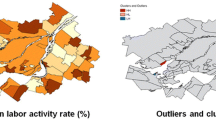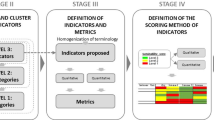Abstract
This chapter discusses the use of urban sustainability indicators. In traditional approaches, the most exemplary cities are designated based on the value of their overall score for a set of indicators. In this chapter, we argue that such interpretation, on its own, is limited because it does not provide a complete description of the main characteristics that make a city “sustainable” or “not sustainable.” A relative threshold based on two performance criteria is proposed for improvement purpose: the non-substitutability between environmental and socioeconomic performance, and the improvement over time. An empirical analysis of the contribution of these criteria to the sustainability assessment is then conducted. Finally, this chapter discusses the implications of such analysis for megacities.
Access this chapter
Tax calculation will be finalised at checkout
Purchases are for personal use only
Similar content being viewed by others
Notes
- 1.
Given the nature of the indicators to be aggregated, the computation of the GI requires to invert the sign for eight indicators for which a lower score indicates a higher performance.
References
Bell, S., & Morse, S. (2008). Sustainability indicators: Measuring the immeasurable? London: Earthscan.
Boutaud, A. (2004). Le développement durable: penser le changement ou changer le pansement? Resource document. University of Jean Monnet. Retrieved June 1, 2014, from http://tel.archivesouvertes.fr/docs/00/78/11/87/PDF/2005_these_A_Boutaud.pdf
Canadian Federation of Municipalities. (2007). Vers une politique de développement durable des municipalités. Québec: Fédération québécoise des municipalités.
City of Montréal. (2010). Le plan de développement durable de la collectivité montréalaise 2010–2015. Resource document. City of Montréal. Retrieved June 1, 2014, from http://ville.montreal.qc.ca/pls/portal/docs/page/pes_publications_fr/publications/plan_2010_2015.pdf
Connelly, S. (2007). Mapping sustainable development as a contested concept. Local Environment, 12(3), 259–278.
Cruz, N. F. D., & Marques, R. C. (2014). Scorecards for sustainable local governments. Cities, 39, 165–170.
Dora Costa, H. B. & Lleras-Muney, A. (2013). Trends in health, education and income In the United States, 1820–2000. Resource document. National Bureau of Economic Research. Retrieved June 1, 2014, from http://www.nber.org/papers/w19162
Economist Intelligence Unit. (2012). Hot spots: Benchmarking global city competitiveness. London: The Economist Intelligence Unit Limited.
Eichholtz, P., Kok, N., & Quigley, J. M. (2013). The economics of green building. Review of Economics and Statistics, 95(1), 50–63.
Emelianoff, C. (2007). La ville durable: l’hypothèse d’un tournant urbanistique en Europe. L’Information géographique, 71(3), 48–65.
European Environmental Agency. (2004). European Environment Agency core set of indicators: letter on consultation process on proposal, proposals for a core set of indicators. Retrieved from http://www.eea.eu.int/coreset
Floridi, M., Pagni, S., Falorni, S., & Luzzati, T. (2011). An exercise in composite indicators construction: Assessing the sustainability of Italian regions. Ecological Economics, 70(8), 1440–1447.
Fraser, E. D., Dougill, A. J., Mabee, W. E., Reed, M., & McAlpine, P. (2006). Bottom up and top down: Analysis of participatory processes for sustainability indicator identification as a pathway to community empowerment and sustainable environmental management. Journal of Environmental Management, 78(2), 114–127.
Gahin, R., Veleva, V., & Hart, M. (2003). Do indicators help create sustainable communities? Local Environment, 8(6), 661–666.
Glaeser, E. (2011). Cities, productivity, and quality of life. Science, 333(6042), 592–594.
Government of Québec. (2012). Sondage sur les démarches de développement durable des organismes municipaux et régionaux. Québec: Ministry of Municipal Affairs, Regions and Land Occupancy. Retrieved June 1, 2014, from http://www.mamrot.gouv.qc.ca/pub/grands_dossiers/developpement_durable/analyse_sondage_integrale.pdf.
Hiremath, R. B., Balachandra, P., Kumar, B., Bansode, S. S., & Murali, J. (2013). Indicator-based urban sustainability—A review. Energy for Sustainable Development, 17(6), 555–563.
Holman, N. (2009). Incorporating local sustainability indicators into structures of local governance: a review of the literature. Local Environment, 14(4), 365–375.
Koller, C. (2006). Le PaLmarès des viLLes romandes et Le besoin de renforcer La statistique urbaine sur Le PLan suisse (méthodoLogie, sources et résuLtats). Revue économique et sociale, 64(1), 101.
Langevin, J., Gurian, P. L., & Wen, J. (2013). Reducing energy consumption in low income public housing: Interviewing residents about energy behaviors. Applied Energy, 102, 1358–1370.
Mancebo, F. (2013). The pitfalls of sustainability policies: insights into plural sustainabilities. Challenges in Sustainability, 1(1), 29–40.
Moonen, T. & Clark G. (2013). The business of cities 2013: What do 150 city indexes and benchmarking studies tell us about the urban world in 2013? Retrieved June 1, 2014, from http://www.jll.com/research/62/the-business-of-cities-2013
Mori, K., & Christodoulou, A. (2012). Review of sustainability indices and indicators: towards a new City Sustainability Index (CSI). Environmental Impact Assessment Review, 32(1), 94–106.
Musterd, S., & Ostendorf, W. (Eds.). (2013). Urban segregation and the welfare state: Inequality and exclusion in western cities. New York: Routledge.
Nardo, M. (2008). Handbook on constructing composite indicators: Methodology and user guide. Paris: OCDE.
Ness, B., Urbel-Piirsalu, E., Anderberg, S., & Olsson, L. (2007). Categorising tools for sustainability assessment. Ecological Economics, 60(3), 498–508.
OECD. (2008). Handbook on constructing composite indicators: Methodology and user guide. Italy: OECD Publishing & Joint Research Center of the European Commission, 162 p.
OECD. (2011). The better life index. Retrieved from http://www.oecdbetterlifeindex.org/
Page, B. I., & Shapiro, R. Y. (2010). The rational public: Fifty years of trends in Americans’ policy preferences. Chicago: University of Chicago Press.
Parkinson, S., & Roseland, M. (2002). Leaders of the pack: an analysis of the Canadian ‘Sustainable Communities’ 2000 municipal competition. Local Environment, 7(4), 411–429.
Pires, S. M., Fidélis, T., & Ramos, T. B. (2014). Measuring and comparing local sustainable development through common indicators: Constraints and achievements in practice. Cities, 39, 1–9.
Planque, B., & Lazzeri, Y. (2006). Elaboration d’indicators pour un système de suivi-évaluation du développement durable: tome 1: Principes et méthodologie de construction du référentiel. Aix-en-Provence: Centre d'Economie Régionale de l'Emploi et des Firmes Internationales.
Portney, K. (2005). Civic engagement and sustainable cities in the United States. Public Administration Review, 65(5), 579–591.
Portney, K. E. & Berry, J. M. (2013). The local environmental Kuznets curve: civil society linkages between economic growth and environmental protection. APSA 2013 annual meeting paper.
Rajaonson, J., & Tanguay, G. A. (2009). Le développement durable au Québec: un classement des 25 plus grandes municipalités. Canadian Journal of Urban Research, 18(2), 40–77.
Rametsteiner, E., Pülzl, H., Alkan-Olsson, J., & Frederiksen, P. (2010). Sustainability indicator development: science or political negotiation? Ecological Indicators, 11(1), 61–70.
Reed, M. S., Fraser, E. D., & Dougill, A. J. (2006). An adaptive learning process for developing and applying sustainability indicators with local communities. Ecological Economics, 59(4), 406–418.
Senecal, G. (2008). L’état de l’environnement urbain au Québec: un coup de sonde auprès des municipalités. Montréal: INRS-Urbanisation, Culture et Société.
Siemens. (2012). Driving sustainability: Sustainability report 2012. Siemens Group, United Nations Global Compact. Retrieved from https://www.unglobalcompact.org/system/attachments/21916/original/siemens-sr2012.pdf?1368191523
Statistics Canada. (2011). Supporting documentation for 2011 Census of Population Program data. Retrieved from https://www12.statcan.gc.ca/census-recensement/2011/ref/index-eng.cfm
Tanguay, G. A. & Rajaonson, J. (2012). Un.e analyse de l’application d’indicateurs de développement durable aux villes québécoises (No. 2012dt-04). CIRANO.
Tanguay, G. A., Rajaonson, J., Lefebvre, J. F., & Lanoie, P. (2010). Measuring the sustainability of cities: An analysis of the use of local indicators. Ecological Indicators, 10(2), 407–418.
Tatham, E. K., Eisenberg, D. A., & Linkov, I. (2014). Sustainable urban systems: a review of how sustainability indicators inform decisions. In I. Linkov (Ed.), Sustainable cities and military installations (pp. 3–20). Netherlands: Springer.
Turcu, C. (2013). Re-thinking sustainability indicators: local perspectives of urban sustainability. Journal of Environmental Planning and Management, 56(5), 695–719.
Valentin, A., & Spangenberg, J. H. (2000). A guide to community sustainability indicators. Environmental Impact Assessment Review, 20(3), 381–392.
Wong, C. (2006). Indicators for urban and regional planning: The interplay of policy and methods. London: Routledge.
Zhang, L., Xue, B., Geng, Y., Ren, W., & Lu, C. (2014). Emergy-based city’s sustainability and decoupling assessment: Indicators, features and findings. Sustainability, 6(2), 952–966.
Author information
Authors and Affiliations
Corresponding author
Editor information
Editors and Affiliations
Rights and permissions
Copyright information
© 2021 Springer Japan KK, part of Springer Nature
About this chapter
Cite this chapter
Tanguay, G.A., Rajaonson, J. (2021). The Urban Sustainability Indicators in Québec. In: Muramatsu, S., McGee, T.G., Mori, K. (eds) Living in the Megacity: Towards Sustainable Urban Environments. Global Environmental Studies. Springer, Tokyo. https://doi.org/10.1007/978-4-431-56901-5_10
Download citation
DOI: https://doi.org/10.1007/978-4-431-56901-5_10
Published:
Publisher Name: Springer, Tokyo
Print ISBN: 978-4-431-56899-5
Online ISBN: 978-4-431-56901-5
eBook Packages: Earth and Environmental ScienceEarth and Environmental Science (R0)




